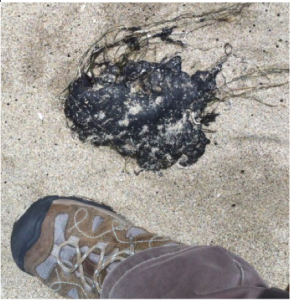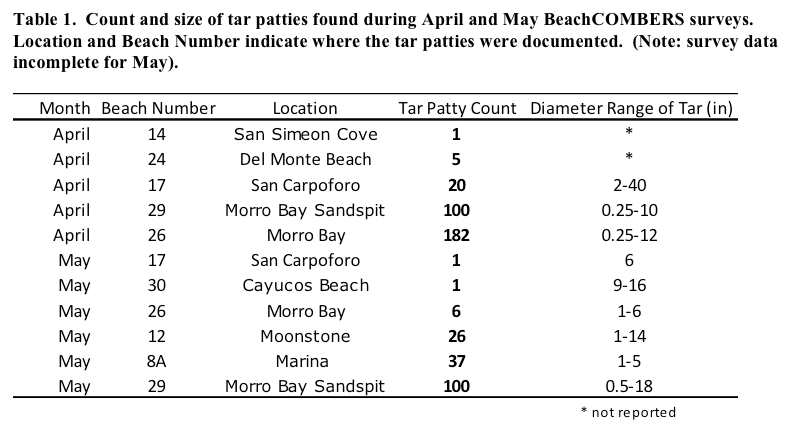
During April and May 2013, Coastal Ocean Mammal and Bird Education and Research Surveys (Beach COMBERS) surveyors documented oiled seabirds and tar patties washing in on beaches in Monterey Bay and south to Morro Bay. The greatest number of tar patties was reported in the southern beaches (Morro Bay Sandsplit and Morro Bay), and the largest tar patties were found on San Carpoforo Beach (Table 1), which is 1.5 miles south of Ragged Point and 13 miles north of San Simeon.
South Beach COMBERS volunteers reported oil and tar patties on the beach as percent of beach coverage. Of the 11 beaches surveyed in April 2013, seven beaches reported <1% tar coverage and four beaches reported 1-10% coverage as isolated patches. In May 2013, reports from these same areas indicated beached tar had declined: four beaches reported <1% and three beaches reported 1-10% coverage as isolated patches.
During April in Monterey Bay, surveyors reported two oiled seabird carcasses: one Northern Fulmar (Morro Bay Sandsplit) and one Cassin’s Auklet (Del Monte Beach). In May, two additional oiled seabird carcasses were documented: a Common Murre (Del Monte Beach) and a Sooty Shearwater (Zmudowski Beach). The four oiled specimens were collected for oil sampling at California Department of Fish and Wildlife, Santa Cruz, and analysis at CA Department of Fish and Wildlife Petroleum Chemistry Lab, Rancho Cordova (CDFW-PCL).
We saw a greater incidence of oiled seabirds in southern Beach COMBER surveys (south of Monterey Bay National Marine Sanctuary). During April, a total of five oiled birds were documented: a Brandt’s Cormorant (Padaro Beach), an unidentified Loon (Holiday Beach), a Northern Fulmar (Ormond Beach), a Western Grebe (Summerland Beach) and a Clark’s or Western Grebe (McGrath SB). During May, four additional birds were reported: a Northern fulmar, an unidentified gull, and a Brown Pelican (McGrath SB), and a Clark’s/Western Grebe (Holiday Beach).
Preliminary results from CDFW-PCL indicate that oil samples were comprised of weathered Monterey Formation, but further analysis is required to confirm the source of the oil.
This update was written by:
Erica Donnelly1, Hannah Nevins1,2,3, and Laird Henkel2
1Coastal Ocean Mammal and Bird Education and Research Surveys (Beach COMBERS), Moss Landing Marine Laboratories, 8272 Moss Landing Road, Moss Landing, CA 95039
2Seabird Health Study, California Department of Fish and Wildlife, Marine Wildlife Veterinary Care and Research Center, 1451 Shaffer Road, Santa Cruz, CA 95062
3University of California at Davis, One Shields Avenue, Davis CA 95616
Updated: 21 May 2013
